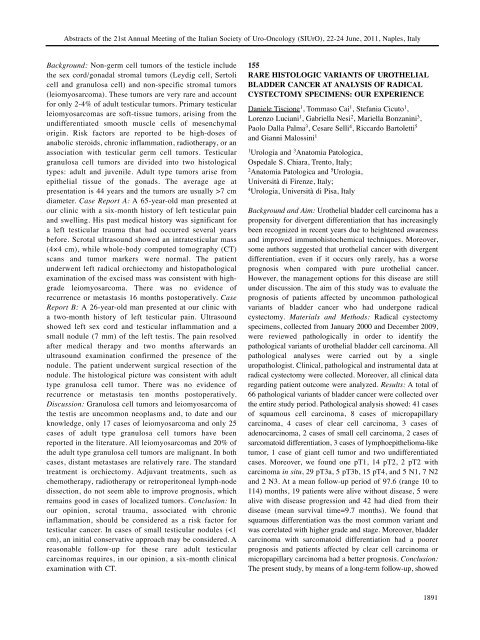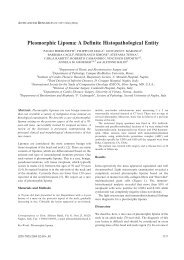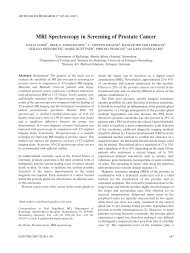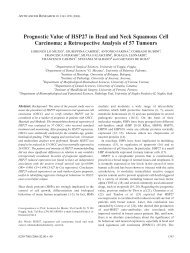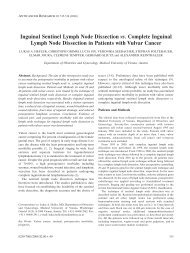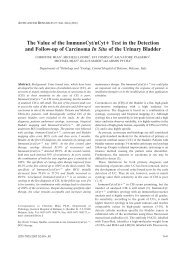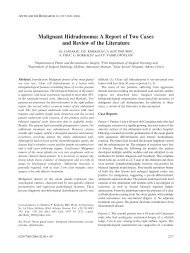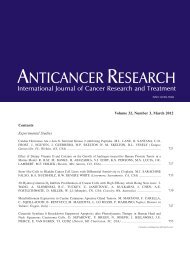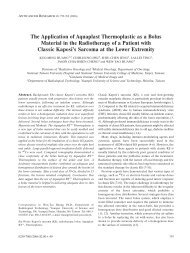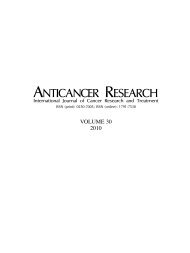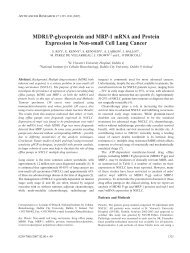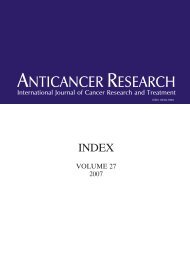ABSTRACTS OF THE 21st ANNUAL MEETING OF THE ITALIAN ...
ABSTRACTS OF THE 21st ANNUAL MEETING OF THE ITALIAN ...
ABSTRACTS OF THE 21st ANNUAL MEETING OF THE ITALIAN ...
You also want an ePaper? Increase the reach of your titles
YUMPU automatically turns print PDFs into web optimized ePapers that Google loves.
Abstracts of the <strong>21st</strong> Annual Meeting of the Italian Society of Uro-Oncology (SIUrO), 22-24 June, 2011, Naples, Italy<br />
Background: Non-germ cell tumors of the testicle include<br />
the sex cord/gonadal stromal tumors (Leydig cell, Sertoli<br />
cell and granulosa cell) and non-specific stromal tumors<br />
(leiomyosarcoma). These tumors are very rare and account<br />
for only 2-4% of adult testicular tumors. Primary testicular<br />
leiomyosarcomas are soft-tissue tumors, arising from the<br />
undifferentiated smooth muscle cells of mesenchymal<br />
origin. Risk factors are reported to be high-doses of<br />
anabolic steroids, chronic inflammation, radiotherapy, or an<br />
association with testicular germ cell tumors. Testicular<br />
granulosa cell tumors are divided into two histological<br />
types: adult and juvenile. Adult type tumors arise from<br />
epithelial tissue of the gonads. The average age at<br />
presentation is 44 years and the tumors are usually >7 cm<br />
diameter. Case Report A: A 65-year-old man presented at<br />
our clinic with a six-month history of left testicular pain<br />
and swelling. His past medical history was significant for<br />
a left testicular trauma that had occurred several years<br />
before. Scrotal ultrasound showed an intratesticular mass<br />
(4×4 cm), while whole-body computed tomography (CT)<br />
scans and tumor markers were normal. The patient<br />
underwent left radical orchiectomy and histopathological<br />
examination of the excised mass was consistent with highgrade<br />
leiomyosarcoma. There was no evidence of<br />
recurrence or metastasis 16 months postoperatively. Case<br />
Report B: A 26-year-old man presented at our clinic with<br />
a two-month history of left testicular pain. Ultrasound<br />
showed left sex cord and testicular inflammation and a<br />
small nodule (7 mm) of the left testis. The pain resolved<br />
after medical therapy and two months afterwards an<br />
ultrasound examination confirmed the presence of the<br />
nodule. The patient underwent surgical resection of the<br />
nodule. The histological picture was consistent with adult<br />
type granulosa cell tumor. There was no evidence of<br />
recurrence or metastasis ten months postoperatively.<br />
Discussion: Granulosa cell tumors and leiomyosarcoma of<br />
the testis are uncommon neoplasms and, to date and our<br />
knowledge, only 17 cases of leiomyosarcoma and only 25<br />
cases of adult type granulosa cell tumors have been<br />
reported in the literature. All leiomyosarcomas and 20% of<br />
the adult type granulosa cell tumors are malignant. In both<br />
cases, distant metastases are relatively rare. The standard<br />
treatment is orchiectomy. Adjuvant treatments, such as<br />
chemotherapy, radiotherapy or retroperitoneal lymph-node<br />
dissection, do not seem able to improve prognosis, which<br />
remains good in cases of localized tumors. Conclusion: In<br />
our opinion, scrotal trauma, associated with chronic<br />
inflammation, should be considered as a risk factor for<br />
testicular cancer. In cases of small testicular nodules (


